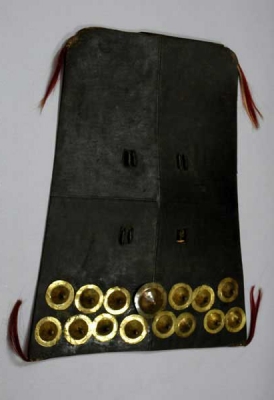Oblong shield (1923.85.951)
 IndiaOblong shield from India, Asia. Collected by John Henry Hutton in 1918. Given to the Museum between 1923 and 1929.
IndiaOblong shield from India, Asia. Collected by John Henry Hutton in 1918. Given to the Museum between 1923 and 1929.
This trapezoidal shield belongs to the Thado Kuki, a warlike clan of the many hill peoples of north-east India, south-west Burma and the Chittagong Hill Tracts of Bangladesh. It was seized in the sacking of a village by British troops during the Kuki Rebellion of 1917-1919.
It is made from the hide of the Mithun or Gaur - the largest bovid on earth (2.1m tall at the shoulder) - and is decorated with tufts of dyed red hair and brass bosses along the bottom.
A Place in History
The name 'Thado' speaks of the clan's bellicose nature since it derives from 'That', 'to kill', and 'Doh', 'to make war'. Like the Naga, the Thado were head-hunters, and collected heads of slain men and animals as offerings to their dead ancestors. The Kukis in general were a martial people who considered war and hunting to be the first and second best pursuits for a man. The Thado dominated their Naga and Manipuri neighbours, keeping them in a vassal state, or driving them out of the lands they claimed.
The British, after establishing rule in Assam in 1826, tried various methods of controlling the independent power and raids of the Kukis but it was clear that this unsubmissive group would be a thorn in the colonial side from the start. Armed with firearms when their neighbours were not, the Thado expanded eastwards into Naga lands in the early 20th century. The British instituted a policy of disarming Kukis when they encountered them, and collected 1,195 indigenously-made flintlock muskets in the decade 1907-17.
This tense and uneasy situation came to an abrupt end in 1917. The Rajah of Manipur had offered his full support to Allied Powers in the Great War of 1914-1918 by raising labourers to ship to France to help the war effort. Thus two thousand Kuki and other Manipuri men were conscripted and sent. This caused obvious discontent among the Kuki and, as the Rajah was in the process of trying to conscript even more troops, the Pipa, the paramount chief of the Thado, raised the Kuki Rebellion, which lasted from 1917 to 1919.
This rebellion followed the traditional course of Thado warfare, involving the Shajam Iha rite, where a Mithun was slaughtered and its meat shared in a communal meal by the willing chiefs. Then a smouldering piece of wood from the cooking fire, wrapped in red chillies, was circulated around the villages to signal war. In the end, 23 Kuki villages rebelled forcibly.
The British put down this rebellion with a massive display of force. Colonel L.W. Shakespear led 2,600 Assam Rifles and 400 Burma Military Police. The General Officer Commanding of the Burma Division, Sir H.D.U. Kerry, wrote at the time: "I...decided to put an end to the Kuki revolt by force of arms, break the Kuki spirit, disarm the Kukis, exact reparation and pave the way for an effective administration of their country." This 'Punitive Expedition' was summarily undertaken, involving a systematic sweeping back and forth across Kukiland by Shakespear's 3,000 men, and the sacking of many villages. This shield was collected in exactly one such sacking, of a village called Aitho.
After the failed rebellion, several chiefs were arrested and jailed and the area was broken up into three distinct administrative zones. Kuki power was slowly eroded although the Naga, whom the colonial regime favoured, did not suffer so harshly.





